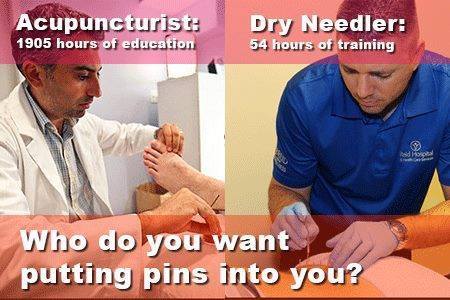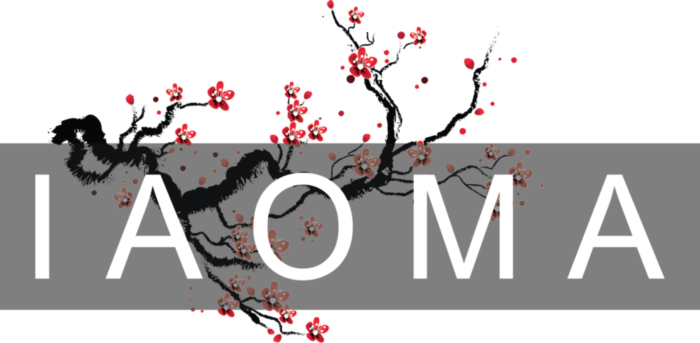Check out the National Center for Acupuncture Safety and Integrity’s 10 Facts You Should Know About Dry Needling.
Position Statements by Medical and Acupuncture professions are linked at the bottom of this page.
More information available in National News.
First off, what is “dry needling?”
At its most basic level, dry needling is a skilled intervention in which a health professional inserts an acupuncture needle into a tight or tender muscle and uses a rigorous pistoning motion of the needle while inside the muscle. It is a painful and dangerous procedure because it is designed to work through damaging the muscle. The needle is supposed to cause micro-damage to help direct the body towards healing the muscle, and the accompanying tightness or pain that the patient initially complained of. It can be a very effective technique when used in situations where other therapies and techniques prove ineffective.

But dry needling is being performed by under-educated individuals.
This is a very concerning issue, especially to acupuncturists who know just how damaging an acupuncture needle can be if used improperly. The principle health professionals who profess to be trained in “dry needling” are physical therapists and occasionally athletic trainers. In the case of physical therapists, they can attend a weekend workshop of 24 hours and believe this makes them qualified, and skilled enough, to offer this dangerous technique. They argue that since they are well-learned in anatomy–especially in the musculoskeletal system–that 24 hours of additional training is all they need to become competent practitioners of dry needling.
Acupuncturists and other medical professionals worry that the abrupt growth of the Physical Therapy “dry needling” trend is going to put patients at risk.
The insertion of acupuncture needles into acupuncture points is, to put it simply, the act and practice of acupuncture. Only licensed, certified, and regulated acupuncturists should perform acupuncture, and thus dry needling (since it is a part of acupuncture). Claiming competence isn’t the same as having it, and the act of acupuncture is highly regulated across the country. In some states, medical doctors aren’t even allowed to use acupuncture needles!
Physical Therapists, and other non-licensed acupuncturists who want to be able to use “dry needling,” will claim that dry needling is different from acupuncture, but it is not. Ah shi points have been documented acupuncture points since well before western health professionals coined the term “trigger points.” The same is true of the needling technique, which acupuncturists have referred to as lifting/thrusting and western health professionals have re-named “pistoning.” But changing the name does not change the essence of the act, and the act is acupuncture.
Dry needling is Acupuncture, but it is being performed by people who are not adequately trained in acupuncture and how to make sure it is practiced as safely and effectively as possible.
Acupuncturists have to maintain certification in their skills and in their ethical conduct through the NCCAOM, and licensure boards require Continuing Education courses every 4 years to make sure acupuncturists are continually demonstrating safety and competence. For Physical Therapists (or Athletic Trainers) who do dry needling, there are no requirements for initially proving or continuing to prove competence. This is especially concerning considering how short typical dry needling training programs are, and how little time is spent in observation and hands-on experience.
So why is this an issue?
Dry needling by non-acupuncturists is unsafe, unethical, and illegal, and yet it will continue to slide into scope of services of physical therapists and athletic trainers unofficially unless we rally to stop it. We owe it to our patients, friends, family, and the public in general to make sure they know exactly what it means when a physical therapist or athletic trainer claims to be trained in dry needling.
What can you do?
First of all, spread the word! Make sure if your friends, family and coworkers are having acupuncture or “dry needling” performed that they are seeing an expert–an acupuncturist–who is fully trained in the use of acupuncture needles. If someone is using acupuncture needles, they should have “Licensed Acupuncturist (L. Ac.)” as their title.
Second, follow us on social media. You can find “Friends of Acupuncture Legislation” on Facebook which is a whole page dedicated to keeping acupuncture safe. You can also follow IAOMA on Facebook.
Third, consider donating to our legal fund. Defending a medical profession from intrusion by less qualified individuals is unfortunately an expensive, but necessary, process. You can make a donation through PayPal down below!
Also keep up to date on news regarding this information here.
Resources
CCAOM (Council of Colleges of Acupuncture and Oriental Medicine) Position Paper May 2011
WFCMS (World Federation of Chinese Medicine Societies) Position Statement February 2016
AAMA (American Academy of Medical Acupuncture) Position Statement
AAPMR (American Academy of Physical Medicine and Rehabilitation) Position Statement June 2012
